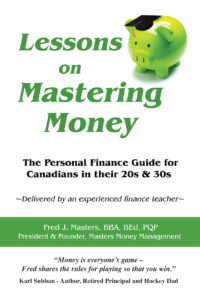Special to the Financial Independence Hub
We are in the midst of a personal financial crisis in this country from coast to coast to coast. The Bank of Canada has been sounding the warning alarm for years that Canadians are taking on way more debt than they can afford. Many are suffering in silence since we just don’t talk about money, and we certainly don’t teach about it.
The goal of my book Lessons on Mastering Money is to empower you – Canadian adults in their 20s and 30s ─ with the core personal financial literacy knowledge needed to control your money on your life’s personal financial journey.
No one should care about your financial well-being more than you. Delegating your financial decision-making to another person, such as a family member or an advisor, leaves you financially blind. You need to be able to ask the right questions and stay involved in the conversations; you need to be at the table so as to understand the decisions.
Success in any organization can often be traced back to strong leadership. Surely, you have witnessed this in your life in countless settings. Once you view your financial life as a very, very important business, then you will instantly recognize that you must put steps in place to financially prosper. Look in the mirror: the person staring back at you owns your financial success.
Mere Hope isn’t going to cut it
By the way, ‘hoping’ for the best financial outcome isn’t going to cut it; you need to understand the financial game because you play it every day of your adult life, and this is one game that we can all win!
There are many personal financial hurdles to overcome in life. Three of the biggest financial tests are saving enough for retirement, saving for the kids’ education and solving the housing-affordability puzzle successfully. These three are crucial. You MUST pass all three of these major financial tests or you will struggle mightily with your financial life: getting just one right or even two of the three right is just not good enough.
You need to get 100% right on this test, and this book provides help with all three of these pieces. Saying that Canadians struggle with debt is a total understatement; there’s help here for this too. A recurring mistake that many Canadians make financially is leasing a brand-new car: there’s guidance around this also. Getting a handle on how you think about and approach your personal finances – your money mindset ─ is really bedrock learning; all good financial decisions lead right back to this. The book begins by teaching you these key money mindset lessons.
6 major thematic sections
The format of the book aligns with the biggest personal financial hurdles that Canadians face. It is broken down into six major thematic sections: Continue Reading…






